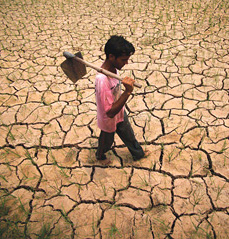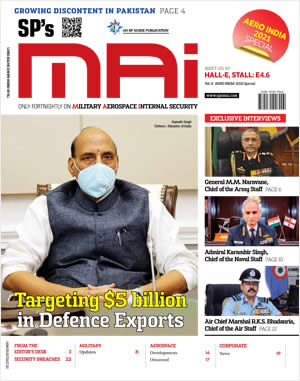INDIAN ARMED FORCES CHIEFS ON OUR RELENTLESS AND FOCUSED PUBLISHING EFFORTS

The insightful articles, inspiring narrations and analytical perspectives presented by the Editorial Team, establish an alluring connect with the reader. My compliments and best wishes to SP Guide Publications.

"Over the past 60 years, the growth of SP Guide Publications has mirrored the rising stature of Indian Navy. Its well-researched and informative magazines on Defence and Aerospace sector have served to shape an educated opinion of our military personnel, policy makers and the public alike. I wish SP's Publication team continued success, fair winds and following seas in all future endeavour!"

Since, its inception in 1964, SP Guide Publications has consistently demonstrated commitment to high-quality journalism in the aerospace and defence sectors, earning a well-deserved reputation as Asia's largest media house in this domain. I wish SP Guide Publications continued success in its pursuit of excellence.
- Indian Air Force Aims for Full Indigenous Inventory by 2047 — Air Chief Marshal A.P. Singh
- General Upendra Dwivedi takes over as the Chief of the Army Staff
- Rajnath Singh assumes charge as Defence Minister for the second consecutive term
- Admiral Dinesh K. Tripathi assumes Command of the Indian Navy as 26th Chief of the Naval Staff
- Prime Minister witnesses 'Bharat Shakti' – a Tri-Services Firing and Manoeuvre Exercise in Pokhran, Rajasthan
Water wars

India constitutes 16 per cent of world population but only four per cent of the world’s freshwater sources. By 2025 we will be a ‘water starved’ nation if we do not manage water on war footing. We need to fight water wars on two fronts – one with external enemies and another the water scarcity within.
On September 20, 2012, Pakistani terrorists struck Jammu and Kashmir’s (J&K) ambitious upcoming Rs. 50-crore irrigation project at Navatour in north Kashmir meant to improve flood protection and conservation of Wular Lake. Heavily armed Pakistani terrorists’ lobbed grenades, assaulted workers and engineers and took away their identity cards.
Earlier, on the night of 27/28 August, Pakistani terrorists threw grenades at the same construction site to scare labourers and contractors. J&K’s Minister for Irrigation and Flood Control described it as “direct attack from Pakistan”. The national media spoke of new type of ‘water wars’ but what is new?
In 1990, the Tulbul navigation project was targeted though the crude explosives didn’t do much damage. In the 1990s, Pervez Musharraf, much before becoming Army Chief, gave a presentation to Pakistani Defence Ministry that the per capita availability of water in Pakistan from 6,000 cusecs of water in 1947 had already come down to 1,000 cusecs per capita and this reason is enough for Pakistan to capture J&K. Consequently, Pakistan started claiming the line of control from NJ9842 directly to Karakoram Pass so that entire Siachen Glacier becomes Pakistani territory.
India constitutes 16 per cent of world population but only has four per cent of the world’s fresh-water sources. By 2025 we will be a ‘water starved’ nation if we do not manage water on war footing. Yet, our military heavy Track-II team wants India to withdraw from Siachen, which is one of biggest freshwater reserves that India has. A major reason why China took over Shaksgam is because of the enormous freshwater source.
Ironically, India gives 80 per cent of waters to Pakistan under the Indus Water Treaty of 1960 – far in excess to global water sharing norms that are dependent on the size of the basin. We should actually give just 50 per cent of what we are giving. Though waters eventually flow across borders, Pakistan keeps objecting to small hydel projects: Kishenganga dam, the Tulbul dam (Wullar barrage) and the Uri-II hydroelectric plant on River Jhelum; Baglihar, Salal and Bursar dams on River Chenab; Kargil dam, Nimmo Bazgo hydroelectric project on River Indus; and Chutak hydroelectric plant on a tributary of Indus.
Akin to terrorism, the problem of water is more internal in Pakistan. Prospect of drought has the potential to plunge Sindh, Baluchistan, Punjab into civil war, not very different from what has happened in Ethiopia and Somalia. This agitation is provincial – “Sindh versus Punjab”. Sindhis allege that Punjabis are conspiring to turn Sindh into a desert by denying their share of Indus water and that a 1991 agreement on water sharing is being violated. Perception in Sindh remains that Punjab is diverting water through its three canals with covert support of the military.
Factually, the Indus south of Sukkur is heavily silted and reduced to streaks. Population and water distribution don’t always correspond. Today, Asia accounts for 60 per cent of global population but only 36 per cent of water. A US intelligence agency report released on March 22, 2012, states, “Beyond 2022, the use of water as a weapon of war or a tool of terrorism will become more likely, particularly in South Asia, Middle East and North Africa.”
India’s options are limited: prepare for more water wars and terrorist attacks on our power/hydel projects; build safeguards against cyber attacks on dams and reservoirs; renegotiate the Indus Water Treaty with Pakistan in conformity with global norms; do not withdraw from Siachen; review own water security, resolve inter-state water disputes and initiate projects like the ‘garland canal system’ in limbo since the 1950s; ensure strict compliance of water harvesting; institutionalise regeneration of bore wells and rivulets and develop national capacity for artificial rain. We need to fight water wars on two fronts – one with external enemies and another the water scarcity within. Do we have the resolve and forethought?
The views expressed herein are the personal views of the author.





